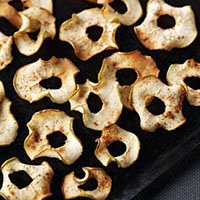A balanced diet for women
When are the best times to eat carbs, protein and fat, what should your portion size be and what are your guideline daily amounts? Choose wisely and you can eat healthily around clock.
.
Women have different daily nutritional requirements to men, and below our nutritionist has offered guidance and recipe ideas for women seeking a balanced diet for good health - but what exactly is meant by a 'balanced diet'? There are some simple rules to follow like getting your five-a-day, including three servings of whole-grains and choosing more fish, poultry and less red meat while opting for low-fat dairy foods. But that's not the whole story - how much should you be eating and when is the best time to eat protein, carbs or fats? Read on for our guide to healthy eating around the clock.
Reference Intake (RI) – the new term for Guideline Daily Amounts (GDAs)
Nutritional needs vary depending on your sex, size, age and activity levels so use this chart as a general guide only. The chart shows the daily amounts recommended for a healthy, balanced diet for maintaining rather than losing or gaining weight. Typically women need less nutrients than men with the exception of salt and fibre.
Guideline daily amounts
| Men | Women | |
| Energy (kcal) | 2500 | 2000 |
| Protein (g) | 55 | 45 |
| Carbohydrates (g) | 300 | 230 |
| Sugar (g) | 120 | 90 |
| Fat (g) | 95 | 70 |
| Saturates (g) | 30 | 20 |
| Fiber (g) | 24 | 24 |
| Salt (g) | 6 | 6 |
Breakfast
Kick start your metabolism by including protein at breakfast, choose from eggs, salmon, lean ham or low-fat dairy. We burn more calories digesting protein rather than carbs so, by making your breakfast a protein one, you'll be revving up your metabolism and because protein foods keep you fuller for longer, you'll eat fewer calories the rest of the day.
A protein breakfast needn't take any longer to prepare - top your morning toast with a scrambled egg, a slice of smoked salmon or some lean ham and when you do have a little more time enjoy an omelette or frittata.
Whatever you do don't skip breakfast as this sets your blood sugar off on a roller coaster, which means you'll end up choosing the wrong foods later in the day. Remember breakfast makes an important contribution towards your daily intake and it plays a key role in maintaining a healthy weight.
Mid-morning snack
Swap your morning biscuits for oatcakes spread with peanut or almond nut butter and a banana or have a tasty dip with veggie sticks.
Lunch
Opt for an open rye-bread sandwich topped with salmon, chicken or low-fat dairy as well as plenty of salad or choose whole-grain toast topped with baked beans
Mid-afternoon
Satisfy that sweet craving and the need for energy with fruit. A handful of dried fruit combined with unsalted nuts or seeds, provides protein and healthy fats to keep you satisfied till supper.
Swap your chocolate or cereal bar for a handful of dried apple rings with a few almonds or walnuts. Dried fruit is four times as sweet as its fresh equivalent - which is great if you've got an exercise class or a gym session planned for the afternoon. Combining dried fruit with nuts helps stabilise the release of their sugars keeping you energised for longer. Alternatively stock your fridge with plenty of low calorie nibbles like cherry tomatoes, grapes and vegetable crudités, which will prevent you reaching for the biscuit tin when you fancy something sweet or crunchy.
Dinner
Don't curfew carbs - they're low in fat, fibre-rich and help you relax in the evening. Combine them with some healthy essential fats the ones you find in oily fish like salmon, mackerel and sardines as well as nuts, seeds and their oils. Your body can use these healthy fats overnight for regeneration and repair, which is important for maintaining healthy skin and hair.
Fill half your plate with a colourful variety of vegetables or salad, drizzle with a dressing made from flaxseed or rapeseed oil and add meat, fish or beans with brown rice, quinoa or wholemeal pasta.










0 comments: